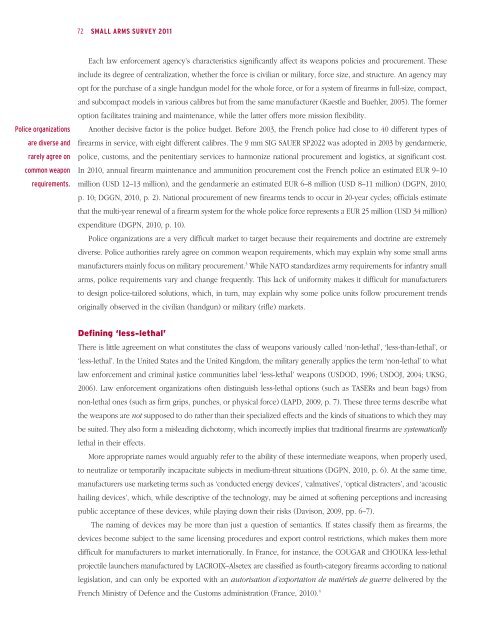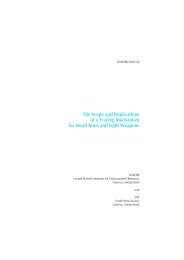A TASER International representative displays a prototype for the ...
A TASER International representative displays a prototype for the ...
A TASER International representative displays a prototype for the ...
You also want an ePaper? Increase the reach of your titles
YUMPU automatically turns print PDFs into web optimized ePapers that Google loves.
72 SMALL ARMS SURVEY 2011<br />
Police organizations<br />
are diverse and<br />
rarely agree on<br />
common weapon<br />
requirements.<br />
Each law en<strong>for</strong>cement agency’s characteristics significantly affect its weapons policies and procurement. These<br />
include its degree of centralization, whe<strong>the</strong>r <strong>the</strong> <strong>for</strong>ce is civilian or military, <strong>for</strong>ce size, and structure. An agency may<br />
opt <strong>for</strong> <strong>the</strong> purchase of a single handgun model <strong>for</strong> <strong>the</strong> whole <strong>for</strong>ce, or <strong>for</strong> a system of firearms in full-size, compact,<br />
and subcompact models in various calibres but from <strong>the</strong> same manufacturer (Kaestle and Buehler, 2005). The <strong>for</strong>mer<br />
option facilitates training and maintenance, while <strong>the</strong> latter offers more mission flexibility.<br />
Ano<strong>the</strong>r decisive factor is <strong>the</strong> police budget. Be<strong>for</strong>e 2003, <strong>the</strong> French police had close to 40 different types of<br />
firearms in service, with eight different calibres. The 9 mm SIG SAUER SP2022 was adopted in 2003 by gendarmerie,<br />
police, customs, and <strong>the</strong> penitentiary services to harmonize national procurement and logistics, at significant cost.<br />
In 2010, annual firearm maintenance and ammunition procurement cost <strong>the</strong> French police an estimated EUR 9–10<br />
million (USD 12–13 million), and <strong>the</strong> gendarmerie an estimated EUR 6–8 million (USD 8–11 million) (DGPN, 2010,<br />
p. 10; DGGN, 2010, p. 2). National procurement of new firearms tends to occur in 20-year cycles; officials estimate<br />
that <strong>the</strong> multi-year renewal of a firearm system <strong>for</strong> <strong>the</strong> whole police <strong>for</strong>ce represents a EUR 25 million (USD 34 million)<br />
expenditure (DGPN, 2010, p. 10).<br />
Police organizations are a very difficult market to target because <strong>the</strong>ir requirements and doctrine are extremely<br />
diverse. Police authorities rarely agree on common weapon requirements, which may explain why some small arms<br />
manufacturers mainly focus on military procurement. 3 While NATO standardizes army requirements <strong>for</strong> infantry small<br />
arms, police requirements vary and change frequently. This lack of uni<strong>for</strong>mity makes it difficult <strong>for</strong> manufacturers<br />
to design police-tailored solutions, which, in turn, may explain why some police units follow procurement trends<br />
originally observed in <strong>the</strong> civilian (handgun) or military (rifle) markets.<br />
Defining ‘less-lethal’<br />
There is little agreement on what constitutes <strong>the</strong> class of weapons variously called ‘non-lethal’, ‘less-than-lethal’, or<br />
‘less-lethal’. In <strong>the</strong> United States and <strong>the</strong> United Kingdom, <strong>the</strong> military generally applies <strong>the</strong> term ‘non-lethal’ to what<br />
law en<strong>for</strong>cement and criminal justice communities label ‘less-lethal’ weapons (USDOD, 1996; USDOJ, 2004; UKSG,<br />
2006). Law en<strong>for</strong>cement organizations often distinguish less-lethal options (such as <strong>TASER</strong>s and bean bags) from<br />
non-lethal ones (such as firm grips, punches, or physical <strong>for</strong>ce) (LAPD, 2009, p. 7). These three terms describe what<br />
<strong>the</strong> weapons are not supposed to do ra<strong>the</strong>r than <strong>the</strong>ir specialized effects and <strong>the</strong> kinds of situations to which <strong>the</strong>y may<br />
be suited. They also <strong>for</strong>m a misleading dichotomy, which incorrectly implies that traditional firearms are systematically<br />
lethal in <strong>the</strong>ir effects.<br />
More appropriate names would arguably refer to <strong>the</strong> ability of <strong>the</strong>se intermediate weapons, when properly used,<br />
to neutralize or temporarily incapacitate subjects in medium-threat situations (DGPN, 2010, p. 6). At <strong>the</strong> same time,<br />
manufacturers use marketing terms such as ‘conducted energy devices’, ‘calmatives’, ‘optical distracters’, and ‘acoustic<br />
hailing devices’, which, while descriptive of <strong>the</strong> technology, may be aimed at softening perceptions and increasing<br />
public acceptance of <strong>the</strong>se devices, while playing down <strong>the</strong>ir risks (Davison, 2009, pp. 6–7).<br />
The naming of devices may be more than just a question of semantics. If states classify <strong>the</strong>m as firearms, <strong>the</strong><br />
devices become subject to <strong>the</strong> same licensing procedures and export control restrictions, which makes <strong>the</strong>m more<br />
difficult <strong>for</strong> manufacturers to market internationally. In France, <strong>for</strong> instance, <strong>the</strong> COUGAR and CHOUKA less-lethal<br />
projectile launchers manufactured by LACROIX–Alsetex are classified as fourth-category firearms according to national<br />
legislation, and can only be exported with an autorisation d’exportation de matériels de guerre delivered by <strong>the</strong><br />
French Ministry of Defence and <strong>the</strong> Customs administration (France, 2010). 4

















